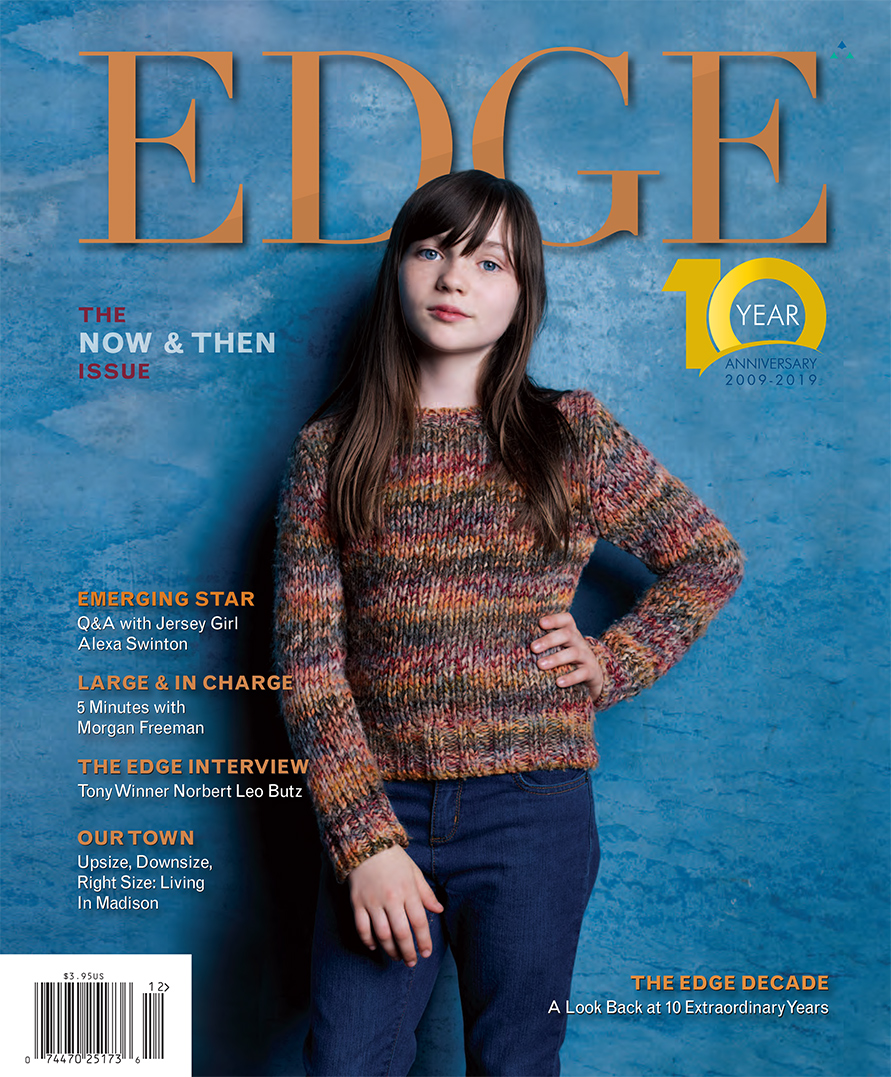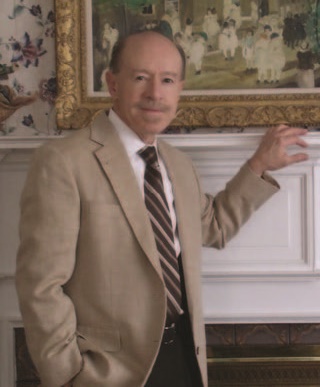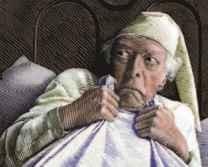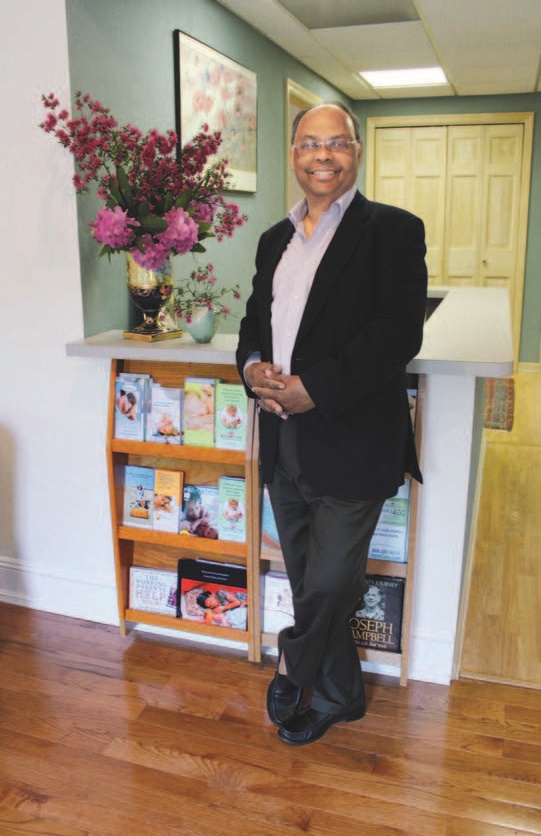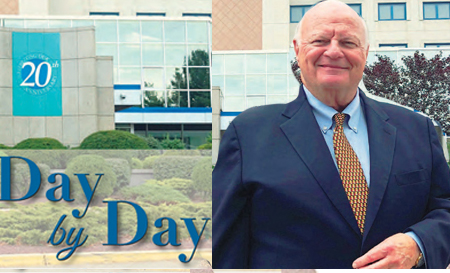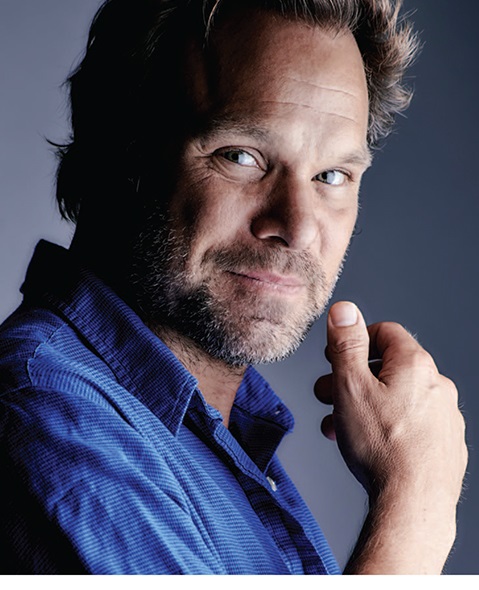Tova Navarra
Take a long look at the work of painter Gary T. Erbe and you’re likely to detect a sophisticated handshake between the familiar and unfamiliar. His paintings embrace the realism and perspective of traditional trompe l’oeil—with a contemporary update that has set him apart from his peers for more than 50 years. The virtual, mysterious, kaleidoscopic, collagistic world Gary T. Erbe puts on canvas can fool the eye—in French, trompe l’oeil—as well as sit you down to many huge holiday meals all at once, literally making your eyes bigger than your stomach.
Born in 1944 in Union City, Erbe is a self-taught artist who had a studio in Union City from 1972 to 2006 before moving to Nutley. Unable to attend art school while young, Erbe worked as an engraver and painter on weekends until he began trompe l’oeil painting à la 19th-century masters. He then developed modern departures from the masters. Erbe has exhibited extensively since 1970 with solo exhibitions at museums and galleries throughout America, Asia, and Europe, and is in the permanent collection of many prestigious institutions. Erbe paints flat forms enhanced by shadow, light, and color for pure three-dimensional illusion and for stimulating the mind. For more information, visit garyerbe.com or go to edgemagonline.com for an extended bio.

Subway Series, 2008 55” x 45”, Oil on Canvas The Heckscher Museum of Art, NY
EDGE takes you inside the area’s most creative kitchens.

Grain & Cane Bar and Table • Grilled Salmon Tikka with Herb Salad
250 Connell Drive • BERKELEY HEIGHTS (908) 897-1920 • grainandcane.com
Scottish salmon marinated in yogurt, spices and flash grilled. Served with a tossed salad of tender herbs, pickled onion and a light citrus vinaigrette. A beautiful early winter dish that has a warm spice finish and pairs beautifully with a light red wine.

The Thirsty Turtle • Pork Tenderloin Special
1-7 South Avenue W. • CRANFORD (908) 324-4140 • thirstyturtle.com
Our food specials amaze! I work tirelessly to bring you the best weekly meat, fish and pasta specials. Follow us on social media to get all of the most current updates!
— Chef Rich Crisonio

The Thirsty Turtle • Brownie Sundae
186 Columbia Turnpike • FLORHAM PARK (973) 845-6300 • thirstyturtle.com
Check out our awesome desserts brought to you by our committed staff. The variety amazes as does the taste!
— Chef Dennis Peralta

The Famished Frog • Mango Guac
18 Washington Street • MORRISTOWN (973) 540-9601 • famishedfrog.com
Our refreshing Mango Guac is sure to bring the taste of the Southwest to Morristown.
— Chef Ken Raymond
 Arirang Hibachi Steakhouse • Pork Belly Bao Buns
Arirang Hibachi Steakhouse • Pork Belly Bao Buns
1230 Route 22 West • MOUNTAINSIDE (908) 518-9733 • partyonthegrill.com
Tender pork belly, hoison sauce and pickled cucumber served on a Chinese bun.

Daimatsu • Sushi Pizza
860 Mountain Avenue • MOUNTAINSIDE (908) 233-7888 • daimatsusushibar.com
This original dish has been our signature appetizer for over 20 years. Crispy seasoned sushi rice topped with homemade spicy mayo, marinated tuna, finely chopped onion, scallion, masago caviar, and ginger. Our customers always come back wanting more.
— Chef Momo

Garden Grille • Beet & Goat Cheese Salad
304 Route 22 West • SPRINGFIELD (973) 232-5300 • hgispringfield.hgi.com
Beet and goat cheese salad with mandarin oranges, golden beets, spiced walnuts, arugula, with a red wine vinaigrette.
— Chef Sean Cznadel

LongHorn Steakhouse • Outlaw Ribeye
272 Route 22 West • SPRINGFIELD (973) 315-2049 • longhornsteakhouse.com
Join us for our “speedy affordable lunches” or dinner. We suggest you try our fresh, never frozen, 18 oz. bone-in Outlaw Ribeye—featuring juicy marbling that is perfectly seasoned and fire-grilled by our expert Grill Masters. Make sure to also try our amazing chicken and seafood dishes, as well.
— Anthony Levy, Managing Partner

Outback Steakhouse • Bone-In Natural Cut Ribeye
901 Mountain Avenue • SPRINGFIELD (973) 467-9095 • outback.com
This is the entire staff’s favorite, guests rave about. Bone-in and extra marbled for maximum tenderness, juicy and savory. Seasoned and wood-fired grilled over oak.
— Duff Regan, Managing Partner

Arirang Hibachi Steakhouse • Japanese Taco
23A Nelson Avenue • STATEN ISLAND, NY (718) 966-9600 • partyonthegrill.com
Choice of Tuna with wakeme, Kobe beef with sushi rice or Rock Shrimp with pineapple. Served in a crispy wonton shell, Asian slaw, topped with spicy mayo and teriyaki sauce

Ursino Steakhouse & Tavern • House Carved 16oz New York Strip Steak
1075 Morris Avenue • UNION (908) 977-9699 • ursinosteakhouse.com
Be it a sizzling filet in the steakhouse or our signature burger in the tavern upstairs, Ursino is sure to please the most selective palates. Our carefully composed menus feature fresh, seasonal ingredients and reflect the passion we put into each and every meal we serve.
Do you own a local restaurant and want to know how your BEST DISH could be featured in our Chef Recommends restaurant guide?
Call us at 908.994.5138
Yolanda Navarra Fleming
If you ask Sharnelle Hubbard, a 50-year-old Elizabeth resident, her life could be a cautionary tale about living on the street and trying to stay high. And when she says she’s spent too many years “running,” she’s not talking about marathons.
“My drug of choice started out as alcohol, and as time progressed, I dabbled with heroin,” she says. “My mother, who suffered from an addiction, introduced me to it when I was 16 years old. Towards the end of my addiction, I was doing alcohol, heroin, crack cocaine, and Suboxone.”
Sharnelle’s birth mother was a functional drug addict until she lost her job and her children. Sharnelle was then adopted by another woman, also a substance abuser, who made sure she had absolutely no chance of any kind of normal life.
In 2017, she hit a wall. “I was in a battered women’s shelter at the time,” she says. “I knew there was help out there, but I wasn’t willing or ready to accept the help yet. Before I knew it, I had been addicted for 20 years, and I just could not live like that anymore. I was a walking time bomb, but I got through all of that.”
She made a commitment to her sobriety by checking herself into a detox center before becoming an outpatient of Trinitas Regional Medical Center’s Behavioral Health program.
Substance Abuse Services (SAS) has been helping people get clean at Trinitas since the early 1990s, and now treats about 4,500 patients annually. Trinitas offers partial-day treatment, which was the route Sharnelle took. She spent Monday through Friday, from 8:30 a.m. to 2:30 p.m. at Trinitas, and then went home every day.
“What people don’t realize is that they need so much support, and that’s what they get here,” says Krystyna Vaccarelli, LCSW, LCADC, and Director of Substance Abuse Services at Trinitas. “During the entire course of the day, the patient is engaged in various groups that address substance use, relapse prevention, understanding triggers, what addiction is, and what addiction is in relation to mental illness. Those are just some of the topics covered when understanding substance abuse on an intensive level.”
Sharnelle had also been diagnosed with bipolar. To this day, the horror of her traumatic past poses an ongoing threat to her mental stability, though you’d never know it now from her clear speech, even temper, and thoughtfulness.
At one point, her counselor, Catherine Elias, LSW, credentialed Intern, noticed that Sharnelle was exhibiting some unusually manic behavior. “So we had an individual session and talked about it,” recalls Elias. “We discovered that there were some issues regarding her medications, and through teamwork with her APN, we got it situated and helped her feel stable.”
Sharnelle’s husband had begun his quest to get off drugs first, which in time motivated her to want to do the same. “I was willing to make a change in my life, and that’s when my process began,” she says. “I went to every session [at Trinitas], and I did everything that was offered to me and more. From 8:30 to 2:30 every day, I was there, and even when my time was up, I found excuses to stay in the program longer.”
At 50, Sharnelle is still trying to make sense of it all, especially now as a sober graduate of the Trinitas outpatient program.
“Going through this process I lost a lot of friends and my mother, worst of all,” she says. “I never thought I would reach the age of 50, not even in my wildest dreams…I am amazed that I am clean and sober.”
According to her former primary counselor at Trinitas, Michelle Defino, LCSW, LCADC, Sharnelle has completed the program. Now, as she is studying to take the GED exam, she is determined never to go backward. She even mentors others who have also concluded that “running” is not a survival tactic, but rather a recipe for disaster. Her two most important sharing points are not to compare yourself or your recovery process to others as we’re all on our own journey, and to take it slow.
“Just don’t give up, there’s always someone there for you,” she promises. “Even when you think you’re alone, you’re not. This process does work.”
Even with her newly developed confidence, Defino confirms, “I do have the same amount of concern today as when Sharnelle first entered treatment. Addiction is a lifetime disease, just waiting around the corner if a patient becomes complacent with her recovery process.”
Sharnelle believes it was the rapport she developed with her counselors, the director, and the entire staff as well as other patients that contributed to her successful outcome.
“When I was in my darkest days and wanted to give up, they always checked on me and called my house,” she says, “and that’s what you need when you’re first starting in recovery; you need people who care. I’ve been taking my medication as prescribed every day thanks to Andrea Krasno (APN), she’s wonderful, and she is amazing. She’s also a great part of this process, I can talk to her about anything regarding my medication; if I want it changed or lowered. I have never had anyone take the time to take care of me like that.”
Sharnelle is happy to add, “Right now I am in a beautiful place in my life. I am clean and sober for two years and I have my children back in my life, as well as my grandchildren. I own my own place, which I never thought I would accomplish. I am married and have a wonderful relationship with my husband. …I go to the meetings, which are great, and I have a sponsor, but I think Trinitas made my recovery whole.”
We welcome the community to our programs that are designed to educate and inform. Programs are subject to change.
SEMINARS
Visit www.TrinitasRMC.org for seminar listings or check for updates on our Facebook page, www.facebook.com/TrinitasRMC.
SPECIAL PROGRAMS
Health Services with Women In Mind
Trinitas helps provide women access to vital health services with a focus on preventive measures. These include educational programs and cancer screenings. Programs offered in English and Spanish.
To learn more about these services, contact Amparo Aguirre, (908) 994-8244 or at amaguirre@trinitas.org
Ask the Pharmacist: Medication Management
Free of charge, by appointment only. Monthly on the 4th Tuesday, 11:30 am – 1:00 pm
Call (908) 994-5237.
Trinitas Health Foundation Events
SUNDAY, NOVEMBER 24 • 12-4 PM
Tailgate with Trinitas
New York Giants vs. Chicago Bears! Watch the game with former Giants greats!
Galloping Hill Caterers, Union, NJ
SATURDAY, FEBRUARY 15
Evening at the Races
Meadowlands Racetrack, Rutherford, NJ
THURSDAY, MAY 14
20th Anniversary Gala
The Venetian, Garfield, NJ
Join the foundation at this beautiful black tie event complete with fantastic live music, dancing, an incredible auction and amazing food and drink.
For more information about the Foundation or to learn more about its fundraising events, (908) 994-8249 or kboyer@trinitas.org.
Proceeds from these events benefit the patients of Trinitas Regional Medical Center. Making reservations for Foundation events is fast and easy on your American Express, MasterCard, Visa or Discover card.
TCCC SUPPORT GROUPS
Conference Room A or Conference Room B Trinitas Comprehensive Cancer Center
225 Williamson Street, Elizabeth NJ 07207
Living with Cancer Support Groups
All events take place from 1:00 – 3:00 pm. Call (908) 994-8535 for 2019 schedule.
MEDICAL AND BEHAVIORAL HEALTH SUPPORT GROUPS
Sleep Disorders
If you are experiencing problems sleeping, contact the Trinitas Comprehensive Sleep Disorders Center in Cranford at Homewood Suites by Hilton (easy access to the GSP). The center is headed by a medical director who is board certified in sleep, internal, pulmonary, and intensive care medicines, and is staffed by seven certified sleep technologists
For further information, call (908) 994-8694
or visit www.njsleepdisorderscenter.org
Narcotics Anonymous
2:00 pm; and Sunday 5:00 – 6:30 pm
Jean Grady, Community Liaison, (908) 994-7438 Grassmann Hall, 655 East Jersey St., Elizabeth
Alcoholics Anonymous
Friday 7:30 – 8:45 pm
Jean Grady, Community Liaison, (908) 994-7438 Grassmann Hall, 655 East Jersey St., Elizabeth
HIV Education and Support Program for HIV Positive Patients
Monthly. Call for scheduled dates/times.
Judy Lacinak, (908) 994-7605 Early Intervention Program Clinic
655 Livingston St., Monastery Building, 2nd Floor, Elizabeth
Mental Illness Support Group (NAMI) for Spanish Speaking Participants
Monthly, Fourth Friday except August, 6:30 – 8:30 pm
Mike Guglielmino, (908) 994-7275 Martha Silva, NAMI 1-888-803-3413
6 So. Conference Rm., Williamson St. Campus 225 Williamson Street, Elizabeth
TRINITAS CHILDREN’S THERAPY SERVICES
899 Mountain Avenue, Suite 1A, Springfield, NJ (973) 218-6394
These workshops are appropriate for parents, teachers, or individuals who work with young children. They focus on practical strategies that can be implemented into daily classroom and home routines. All workshops offer suggestions that are appropriate for all children. A special emphasis is placed on children with special needs and those with an Autism diagnosis.
Workshops are $15 per class.
November 19, 2019 6:00 – 7:30 pm 10 Tips for Looking at Behavior Through a Mental Health Lens
December 10, 2019 6:00 – 7:30 pm
10 Tips – Make & Take Evening (make activities to take back & use in your classroom)
Limited number of registrants.
To register, e-mail your name and courses you would like to attend (include dates) to Kellianne
Martin at Kmartin@trinitas.org or by phone at (973) 218-6394 x1000.
Winter Programs: Oct. 21 – Feb. 7
All programs are offered one time per week, for 45 minutes. These programs are a great alternative to individual therapy. They give children the oppor- tunity to address key developmental areas in structured environments that are more reflective of typical real-life home
and school situations.
Call for times and pricing.
SCRIBBLES TO SCRIPT HANDWRITING PROGRAM
An opportunity for children from preschool (prewriting) through elementary (cursive) school to work with an occupational therapist and participate in multi-sensory fine motor, visual-motor, and visual-perceptual activities to learn pre-writing skills, proper letter formation, and writing within the given lines using the Handwriting Without Tears® program.
SPORTS READINESS
An opportunity for children to work with a physical therapist and have an intro into several fall/winter sports in a non-competitive small group setting.
SOCIAL BUTTERFLIES
An opportunity for children to work with a speech & language therapist and engage in activities to address turn-taking, topic maintenance, appropriate question asking, following non-verbal cues, and using manners.
TYPING WHIZKIDS
An opportunity for children to work with an occupational therapist to learn efficient keyboarding skills, including key location and finger placement, and speed and accuracy.
Schedule of Events
November 20 to December 29
Paper Mill Playhouse
(Check web site for show dates and times.)
Rodgers & Hammerstein’s Cinderella
The Tony-nominate Broadway musical features some of the songwriting duo’s most memorable tunes, including “Impossible” and “In My Own Little Corner.”
Tuesday • December 3 • 8:00 pm
Wednesday • December 4 • 8:00 pm
State Theatre
Jersey Boys
The Broadway megahit traces the ascent of Frankie Valli and the Four Seasons. But you know that already. The show has a Tony and a Grammy to its credit, and spun off a movie, to boot!
December 4 to December 29
The Shakespeare Theatre of New Jersey
(Check web site for show dates and times.)
Charles Dickens’
A Christmas Carol
Brian Crowe directs this production of the beloved holiday classic, adapted for the stage by Neil Bartlett.

NJPAC
Wednesday • December 4 8:00 pm
NJPAC
Taylor Mac
Holiday Sauce
The Tony-nominated force of nature Taylor Mac makes his NJPAC debut with an utterly outrageous holiday extravaganza. Not even remotely your father’s Christmas show.

NJPAC
Sunday • December 8 7:00 pm
NJPAC
Trilogy Opera Company
Sassy
The Victoria Theater hosts the return of Trilogy for a performance celebrating the life and work of Newark legend Sarah Vaughn, composed by Dorothy Rudd Moore.

State Theatre
Friday • December 20 • 8:00 pm
Saturday • December 21 2:00 & 8:00 pm
Sunday • December 22 • 2:00 pm
State Theatre
Fiddler On the Roof
Director Bartlett Sher brings a fresh look to this classic musical, with choreography by Hofesh Shechter

NJPAC
Saturday • January 25 • 2:00 pm
Sunday • January 26 • 2:00 pm
NJPAC
Nai-Ni Chen Dance Company
Year of the Golden Rat
NJPAC’s annual Chinese New Year celebration features choreographer Na-Ni Chen’s dance troupe on stage in the Victoria Theater.

State Theatre
Thursday • January 30 • 8:00 pm
Friday • January 31 • 8:00 pm
Saturday • February 1 • 2:00 & 8:00 pm
State Theatre
The Color Purple
The State plays host to four performances of the Tony- and Grammy-winning musical featuring a mix of ragtime, jazz, gospel and blues.
January 30 to March 1
Paper Mill Playhouse
(Check web site for show dates and times.)
Unmasked: The Music of Andrew Lloyd Webber
The world premiere of a musical celebrating the life and work of one of history’s most prolific musical theater’s composers. The show includes highlights from Phantom of the Opera, Evita, Cats, Sunset Boulevard and Jesus Christ Superstar.

NJPAC
Saturday • February 8 • 2:00 & 7:30 pm
NJPAC
New Jersey Symphony Orchestra
Star Wars: Return of the Jedi In Concert
The NJSO performs John Williams’ score of the classic sci-fi film, presented simultaneously on the big screen in Prudential Hall.
FUNNY YOU SHOULD MENTION IT

NJPAC
Friday • November 29 8:00 pm
NJPAC
DeRay David and Friends
Thanksgiving Comedy Fest
DeRay Davis headlines a comedy lineup that includes Tony Rock and Jessica Moore. Davis soared to stardom after his Netflix special How to Act Black and developed a new following as hit-man Jermel on the FOX series Empire.

UPAC
Saturday • November 30 • 8:00 pm
UCPAC
Kreeps with Kids
Comedy Tour
Robert Kelly, Ron Bennington, Rich Voss and Jim Florentine team up for a truly unforgettable evening of adult childishness.

UCPAC
Saturday • December 14 • 8:00 pm
UCPAC
Sinbad Live On Stage
The popular stand-up returns to
Rahway, where he sold out his 2016 show.

NJPAC
Sunday • December 29 • 7:00 pm
NJPAC
Michael Carbonaro Live On Stage
The star of TV’s beloved The Carbonaro Effect comes to NJPAC with his blend of crazy antics and mind-bending magic.

NJPAC
Saturday • February 8 • 3:00 & 7:30 pm
NJPAC
Drum Tao Live On Stage
A pulse-pounding, family-friendly performance of this off-Broadway hit.
INNER CHILD
Friday • November 29 • 8:00 pm
Saturday • November 30 • 2:00 & 8:00 pm
Sunday • December 1 • 2:00 pm
State Theatre
The SpongeBob Musical
The 2018 Drama Desk pick for Best Musical crosses the Hudson for four performances on the State Theatre stage.

NJPAC
Saturday • November 30 • 10:00 am, 2:00 & 6:00 pm
Sunday • December 1 • 10:00 am & 2:00 pm
NJPAC
Paw Patrol Live The Great Pirate Adventure
Nick Jr.’s animated series comes to life on the Prudential Hall stage as Ryder and his fellow rescue dogs follow the clues on a secret treasure map.
STAGE CRAFT

NJPAC
Saturday • November 23 3:00 & 7:00 pm
NJPAC
Maurice Hines
Tappin’ Thru Life
The legendary tap master is joined by the Diva Jazz Orchestra and the Manzai Brothers for two performances from his off-Broadway show.

NJPAC
Saturday • December 28 3:00 & 7:00 pm
NJPAC
Holiday Dreams
Billed as a spectacular holiday cirque, this performance features acrobats, aerialists, music and a jaw-dropping laser-light show.
Saturday • January 11 • 8:00 pm
UCPAC
Jeremy Jordan Live On Stage
Broadway star Jeremy Jordan returns to Rahway for an unforgettable one-man show.
CRACKIN’ GOOD

State Theatre
Friday • December 13 • 8:00 pm
Saturday • December 14 • 2:00 & 7:00 pm
State Theatre
American Repertory Ballet
The Nutcracker
ARB comes to The State with a cast of 100-plus performers under the artistic direction of Douglas Martin.

NJPAC
Saturday • December 14 • 2:00 & 7:00 pm
NJPAC
National Ballet Theatre of Odessa
The Nutcracker
Tchaikovsky’s beloved score sets the stage for Marius Petipa’s original choreography and sumptuous sets and costumes.

NJPAC
Friday • December 20 • 7:00 pm
Saturday • December 21 • 2:00 pm
NJPAC
Kurtis Blow
The Hip-Hop Nutcracker
Fast becoming a Brick City tradition, this telling of the classic holiday tale features rap legend Kurtis Blow as MC and a cast of edgy, high-energy performers.
OH, CLASSIC

NJPAC
Sunday • November 24 • 8:00 pm
NJPAC
National Symphony Orchestra of Ukraine
In Concert
The Kiev-based NSOU makes its NJPAC debut featuring pianist Olga Kern and conducted by Volodymyr Sirenko in a program of cherished Russian works.

NJPAC
Thursday • December 5 • 1:30 pm
Friday • December 6 • 8:00 pm
Sunday • December 8 • 3:00 pm
NJPAC
Saturday • December 7 • 8:00 pm
State Theatre
New Jersey Symphony Orchestra
Rachmaninoff’s 3rd Piano Concerto
Pianist George Li is featured in the NJSO’s performance of three unforgettable works.

State Theatre
Tuesday • December 31 5:00 pm
State Theatre
Kiev-Aniko Ballet of Ukraine
Salute to Vienna
The Kiev-Aniko Ballet teams with champion ballroom dancers for a New Year’s Eve concert that evokes the golden age of Vienna.
Friday • January 3 • 8:00 pm
NJPAC
New Jersey Symphony Orchestra
Winter Festival: Romeo and Juliet
The NJSO performs works by Prokofiev and Clara Schumann behind pianist Inon Barnatan and conductor Xian Zhang.

NJPAC
Saturday • January 11 • 8:00 pm
NJPAC
Sunday • January 12 • 3:00 pm
State Theatre
New Jersey Symphony Orchestra
Winter Festival: Don Giovanni
Comedy, tragedy, the supernatural—Mozart’s opera has it all, with the added bonus of Eric Wyrick on violin.
Saturday • January 18 • 8:00 pm
State Theatre
Sunday • January 19 • 3:00 pm
NJPAC
New Jersey Symphony Orchestra
Winter Festival: The Ring Without Words
Pianist Simon Trpčeski is featured in a program highlighting the towering works of Wagner and Lizst.
NOTEWORTHY

Prudential Center
Saturday • November 16 • 7:30 pm
Prudential Center
TOOL In Concert
Three-time Grammy winners come to Newark in support of their new album, Fear Inoculum. The “thinking man’s metal band” has built a unique artsy following over the past two decades, and was one of the last U.S. bands to release its music digitally.

Prudential Center
Friday • November 22 7:30 pm
Prudential Center
Jonas Brothers
Happiness Begins Tour
The multiplatinum brother act returns to The Rock on their biggest tour ever. They’ll be joined on stage by special guests Bebe Rexha and Jordan McGraw.
Saturday • November 23 • 8:00 pm
State Theatre
The Fab Faux
Beatles Movie Music
The legendary Beatles tribute band performs selections from A Hard Day’s Night, Help, Magical Mystery Tour and Yellow Submarine.
Sunday • November 24 • 11:00 am & 1:00 pm
NJPAC
Houston Person
Saxophone virtuoso Houston Person headlines two brunch-time performances at NJPAC’s Nico Kitchen+Bar in the latest edition of the Dorthaan’s Place series.

UCPAC
Sunday • December 15 • 8:00 pm
UCPAC
Martina McBride
The Joy of Christmas Tour
Country superstar Martina McBride performs selections from It’s the Holiday Season, along with a few of her six #1 hits.
Sunday • December 15 • 4:00 pm
NJPAC
Boston Pops In Concert
This is the holiday show that has entertained generations, conducted by Keith Lockhart.

State Theatre
Friday • December 26 • 8:00 pm
State Theatre
Béla Fleck & The Flecktones In Concert
The group’s original lineup is together in support of their latest album, Rocket Science.

NJPAC
Saturday • January 18 • 8:00 pm
NJPAC
Stephanie Mills In Concert
The legendary Stephanie Mills takes the Prudential Hall stage with R&B super group The Whispers as part of NJPAC’s annual MLK celebration.

NJPAC
Sunday • January 26 • 3:00 pm
NJPAC
Classical Mystery Tour
Sgt. Pepper’s Lonely Hearts Club Band
The Beatles tribute band teams up with members of NJSO for a concert featuring their most iconic album… and more.
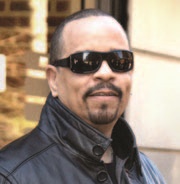
UCPAC
Saturday • February 15 • 8:00 pm
UCPAC
Ice-T In Concert
NJ-born actor, rapper, producer, entrepreneur Ice-T takes the Main Stage for a raucous live performance.

Prudential Center
Saturday • March 7 • 7:30 pm
Sunday • March 8 • 7:30 pm
Prudential Center
Celine Dion
Courage World Tour
The record-shattering powerhouse performer appears on back-to-back nights in the 2020 leg of her Courage tour.
Editor’s Note: For more info on these listings log onto the following web sites:
NJPAC • njpac.org
Paper Mill Playhouse • papermill.org
Prudential Center • prucenter.com
State Theatre • stnj.org
The Shakespeare Theatre of New Jersey • Shakespearenj.org
Union County Performing Arts Center & Hamilton Stage • ucpac.org
“Laird loves duck, a food he knows most folks do not make at home and, as such, is a celebratory dish.”
By Andy Clurfeld
Elegance doesn’t become every restaurant that opens its doors to the public. But it has been the guiding force behind Restaurant Serenade since its birth in 1996, two years after its owners, James and Nancy Sheridan Laird, met and fell in love in the kitchen of the Ryland Inn and knew that, together, they had what it takes to create the kind of forever-classic Balanchine did by putting mind and body to the music of Tchaikovsky.
Twenty-five years ago, I did a stage at Ryland for a story I was reporting for the Asbury Park Press. I saw then-sous chef James break concentration only to steal a glance at Nancy, an extern from the CIA who’d left a successful career in finance to pursue a passion for all things culinary. Nancy, laser-focused on learning and little interested in offering comments for my story, only eked out an observation at the end of my stage, by noting how impressed she was by James’ talent and skill, leadership and devotion to serving exquisite food.
As EDGE marks its 10th anniversary, I could think of no finer restaurant to profile in commemoration of that achievement than Restaurant Serenade in Chatham, which has been the scene of thousands of anniversary toasts since the Lairds decided to create a restaurant that brought elegance to every aspect of the dining experience—and made it accessible and welcoming, to all.
It’s a Saturday night, and Serenade is packed. There’s a private party in The Loft, the tables in the dining spaces are taken by couples, by small groups, by the fortunate who’ve scored a babysitter, and the high-tops in the bar are tete-a-tete central. It’s a festive and comfortable scene. It’s also something of a bargain in the highest end of the fine-dining spectrum, with the regular weeknight bill of fare giving way to an across-the-board $73-per-person fixed-price three-course menu. It’s aimed at showcasing, on the busiest night, what

Photos courtesy of Restaurant Serenade
James, the chef, and Nancy, who manages the restaurant and oversees front-of-house operations, made their mission when they opened Serenade 23 years ago this fall: beautiful foods in the Mediterranean style, fresh, seasonal, light of touch and yet deeply layered with flavor.
Keep the calculations coming by digging into halibut whose sear is capped by a sliver-slice of tomato that melts into the fillet and links it to quenelle-shaped mounds of ratatouille, verdant beans and peas, and the sultry spray of a sun-dried tomato vinaigrette. Very Provencal, very clean, very easy to eat…as was a roasted rack of lamb, bones playfully akimbo, served with pert cylinders of smashed-potato strudel and a crown of broccoli. Here, there was the counterpointing underpinning of piquant chimichurri and smolderingly sweet oven-dried tomatoes, accents at once light and potent. Laird loves duck, a food he knows most folks do not make at home and, as such, is a celebratory dish. He gets his duck from Pennsylvania, riffs on it seasonally, but always follows a low-and-slow roasting dictum for his Saturday night special. On this particular night, he’s taken a honey glaze scented with coriander, cumin and white pepper that tames slightly the richness of the duck and seeps happily into—for one example—risotto.

Photos courtesy of Restaurant Serenade
The Lairds always have been patrons of New Jersey’s farms and food artisans and are quick to name, on the menu and in conversation, those whose produce and products inspire and frame Serenade’s cuisine. It’s no surprise, then, that the pitch-perfect peach cobbler gives top nod to Melick’s Town Farm in the nearby village of Oldwick in Tewksbury Township and that both Nancy and James speak of patriarch George Melick, his wife Norma, and their three now-middle-aged children, Peter, John, and Rebecca, as the prime source for much of the produce they use. If you’re in search of something non-fruit in the finale department, there’s a chocolate tart served warm and made memorable by a pecan crust, or if you cotton to a Southern-style stately cake, the coconut number has a debutante’s posture and a scoop of cantaloupe sorbet, to boot.
At the end of our dinner, James Laird stops by our table. He hasn’t aged a day in the 25 years since we first met at Ryland, but it’s been quite a few years since I’ve seen and spoken with him. I can’t help but noting he’s the human fountain of youth. James insists it’s the food. “It’s just eating well,” he says, then takes note of the local farmers and foragers who are so much a part of the night’s menu. He heads back to the kitchen.

Photos courtesy of Restaurant Serenade
As we leave, the gorgeous and gracious Nancy Laird is saying goodnight to diners. I wait a minute so I can ask about the fabulous orange chairs in the dining room. She smiles broadly, then asks, “Did you see the wallpaper in the women’s room?” I take off for points private. It’s the most amazing splash of color and composition, floral and bold and absolutely fun. Nancy assures me the men’s room has an exciting paper backdrop all its own.
I’m not much for oohing and ahhing over décor in restaurants, but I need to know about this wallpaper. “It’s from Brooklyn,” she says. “Made by Flavor.”
“Flavor?” I repeat.
“Yes,” Nancy says. “Flavor is the name of the company.”
Of course, it is. Of course, Nancy and James Laird, and Restaurant Serenade, would have wallpaper from Flavor.
An Anniversary Chat
A couple of days after our dinner at Restaurant Serenade, I spoke with Nancy and James Laird by phone to ask them a few questions. Mostly I wanted to know, after marking so many years in a competitive industry, how they keep the magic going.
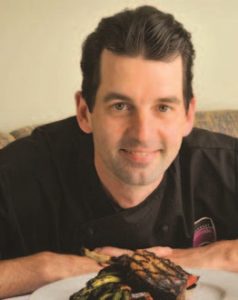
Photos courtesy of Restaurant Serenade
James: I think we keep the magic by keeping the restaurant fresh. The restaurant is ours, the chef will never leave, but we can change little things to keep it fresh.
Nancy: Wall sconces, for instance. James: Every time we spend a little, we get busier. When I was 18, 20 years old [and cooking in a restaurant] in France, there was a chef who’d been there 27 years, just as dedicated. Nancy and I keep the magic in marriage, as well as the restaurant—we figured out what she’s good at and what I’m good at.
Nancy: Now we have 35 employees, and we seat 100 to 120 or so, including the bar. These employees mean a lot to us. A lot.
James: Most are married, with kids, so we feel like we’re responsible for feeding about 100 mouths! They work hard for us.

Photos courtesy of Restaurant Serenade
Nancy: It helps that we have a good marriage. It’s been 23 years for both the marriage and the restaurant. In March 1996, we got married and in October 1996, we opened the restaurant. We knew we wanted to be in this for the long haul. So we didn’t get greedy, we never overbooked the restaurant.
James: We like what we do; we like to make people happy. I think I’ve become a better person, more humble.
Nancy: Part of the reason we do this is the community. Most of our friends, we’ve met through this community. We’ve looked at other spaces, but we have a really nice life here. I feel like we were meant to do this restaurant and do it really well.
James: In my opinion, I’d rather do one, and do it perfectly. You know, we don’t do VIP—every one is treated the same way. Recently, we had a couple come in, a freshman in college and a senior in high school. They were celebrating their six-month anniversary. We went over to them, we gave them more attention than anyone.
James wants to add one more thing before we sign off. His youthful looks? “It’s love,” he says, as I imagine him glancing at Nancy much as he did the first time I saw him. “Love keeps you young.”
“The world has changed over the last 10 years. Automotive technology has changed along with it.”
Jim Sawyer
How cool would it be to walk into a car dealership and see something truly revolutionary—an out-of-this-world technology so new that no one had even thought of it a year ago? Well, revolutions don’t happen overnight, at least not in the automotive industry. Improvements in in-car technology tend to be incremental. And thank goodness for that. We are consumers, not crash-test dummies—we want all the kinks worked out of the new cars we buy before we drive them off the lot, and are willing to wait until they are more or less perfected.
Which is why great leaps forward are few and far between. However…if you take what I like to call the “Rip van Winkle” approach and assess improvements in performance, safety, and design in decade-long chunks, the last 10 years (2009 to 2019) have offered plenty to get excited about. Of course, being human, we now take most of them for granted, but they are well worth appreciating.
Just Around the Corner
Vehicle-to-vehicle networking. Right now, if the car ahead of you senses an obstacle or impending accident, its sensors can give the driver an extra split-second to react. You, on the other hand—in the “third car”—are out of luck. The future of connectivity will give your car (and others in close proximity) the same warning at the same time.
“This is going to be a big deal,” predicts DCH Audi General Manager Al Kouri, adding that networking technology will also be a game-changer in the development of fully autonomous vehicles.
 The fact is that 2009 was a big year for auto tech. Many of the now ”standard” features on 2019 vehicles were just finding their way into showrooms back then. Among the groundbreaking bells and whistles were rear-mounted radar that could detect oncoming traffic when a car shifted into reverse, as well as portable routers that turned vehicles into Wi-Fi hotspots. Live GPS vehicle tracking (for paranoid parents or vigilant business owners) also became widely available. And smaller, lighter turbocharged engines could be found in cars across the MSRP spectrum, boosting power and efficiency—a huge game-changer.
The fact is that 2009 was a big year for auto tech. Many of the now ”standard” features on 2019 vehicles were just finding their way into showrooms back then. Among the groundbreaking bells and whistles were rear-mounted radar that could detect oncoming traffic when a car shifted into reverse, as well as portable routers that turned vehicles into Wi-Fi hotspots. Live GPS vehicle tracking (for paranoid parents or vigilant business owners) also became widely available. And smaller, lighter turbocharged engines could be found in cars across the MSRP spectrum, boosting power and efficiency—a huge game-changer.
The 2010’s saw a number of other noteworthy changes and improvements, some of which are everywhere now, some which are not and, a few (like sophisticated back-up cameras) that became mandatory in all new cars. In 2010, for instance, Volvo introduced a crash- avoidance system that sensed pedestrians, cyclists and other urban hazards, which it dubbed City Safety. This technology, which has become more important in new cars as more and more people step off curbs while glued to their smartphones, will be a key part of making driverless cars a reality. An autonomous vehicle can do a lot of things, but can it ever replace a human driver who can read and react to what a cyclist or pedestrian or loose pet might do? We shall see.
“Pre-sensing technology has been the most significant improvement,” confirms Al Khouri, General Manager of DCH Millburn Audi in Maplewood. “Safety features used to be about protecting passengers in an accident. Vehicles now assist the driver in avoiding that accident. This has changed the conversations we have in the showroom. It used to be that people wanted to feel how a car drove and handled. Now they want to know all about safety technology. These questions were rarely asked a decade ago. Consumers have done their research and are well-informed.”
Given that car design and technology usually reflect trends in the wider world, it should come as no surprise that many of the game-changing technologies we’ve seen over the last decade are related to our love of electronics. Indeed, the headline news in the auto industry seemed to come from the Consumer Electronics Show every winter. Lasers, sensors, satellite receivers, display screens, sophisticated driver-assist functions, connectivity and more apps than can fit on a smartphone combined to enhance the in-car experience for drivers and passengers.
At the beginning of the decade, the automotive green revolution got important boosts from a couple of noteworthy cars: the Tesla Roadster and Ford Fusion Hybrid (pictured on the previous page). The Tesla was the first truly heart-pounding electric super-vehicle (in that it looked more like a sexy sports car than an appliance on wheels). The Fusion, which hit the road at about the same time, targeted a different segment of the market with the look of an everyday sedan but with the efficiency of a hybrid. Together, these two cars pushed other companies to up their games and convinced a lot of reluctant consumers to consider an environmentally friendlier option when it was time for their next new car.
Do they qualify as great leaps forward? That depends on your definition of great or, perhaps, your definition of leap. The term “Great Leap Forward” was famously adopted by the People’s Republic of China in the late-1950s to describe an ambitious plan to move from an agrarian to an industrialized society. It turned out to be an economic demolition derby—it was an utter catastrophe. So how ironic that, when car industry experts look back at 2019 years from now, a legitimate great leap forward may have come from China’s neighbor, Taiwan. Last spring, engineering researchers at National Qinghua University announced that they had found a way to potentially double the efficiency of the alkaline fuel cells used to power electric vehicles while reducing manufacturing costs by as much as 90%.
That, my friends, would be a great leap forward!
Near Future
 3-D Printed Cars. Not the whole car, of course, just the parts that make people ooh and aah. Pick your engine and your options, and then go crazy designing the car of your dreams. The functional technology exists already, however, the cost is still prohibitive. But man, just think of the wild stuff we’ll be seeing on the road. The fringe benefit of this technology is that the same 3-D printers will also be able to create parts on demand, drastically reducing repair costs and doing the environment a solid.
3-D Printed Cars. Not the whole car, of course, just the parts that make people ooh and aah. Pick your engine and your options, and then go crazy designing the car of your dreams. The functional technology exists already, however, the cost is still prohibitive. But man, just think of the wild stuff we’ll be seeing on the road. The fringe benefit of this technology is that the same 3-D printers will also be able to create parts on demand, drastically reducing repair costs and doing the environment a solid.
Not So Distant Future
Fully autonomous driving should be a reality. Not only will all the kinks be worked out of the technology, but so will various legal issues and (hopefully) any unintended social or cultural consequences. What unintended consequences? Well, in a city like New York, where traffic is bad and parking hideously expensive, self-driving cars might potentially worsen congestion. Why park for $50 during a one-hour meeting or meal when you could “tell” your car to just circle the block? And if the city outlaws this practice, how do cops stop and ticket a driverless car? Interesting, right? Undoubtedly, technology will address this problem, but it won’t happen overnight, as we’ve been led to believe.
Not In Your Lifetime
 Flying cars. Well, 1973 came and went, didn’t it? So here’s the deal: You might finally get that long-awaited personal jetpack, but automobiles will remain earthbound. Yes, it’s fun to imagine hovering over the potholes on Rte. 22 on your way to and from work, but no one wants to be in a Rte. 22 fender- bender “at altitude”—or, especially, be driving underneath one!
Flying cars. Well, 1973 came and went, didn’t it? So here’s the deal: You might finally get that long-awaited personal jetpack, but automobiles will remain earthbound. Yes, it’s fun to imagine hovering over the potholes on Rte. 22 on your way to and from work, but no one wants to be in a Rte. 22 fender- bender “at altitude”—or, especially, be driving underneath one!
Trinitas OB/GYN Chair making Elizabeth campus his base of operations.
Erica Otersen
Dr. Abu S. Alam has delivered thousands of babies and provided quality care to countless families, both here and abroad, during a medical career that has stretched across more than four decades. After two-plus years commuting between Elizabeth and his practice in Summit, the Chairman of Obstetrics/Gynecology has decided to close the doors of his longtime office overlooking Springfield Avenue and devote himself entirely to Trinitas.
Born and raised in Bangladesh, Dr. Alam cites his father’s death as his inspiration for a career in healthcare: “Before my father passed, he asked that one of us become a doctor. At sixteen, I was the youngest of seven children and none of my siblings had pursued medicine. It was left to me to fulfill his wishes.”
He embarked on his medical education as a teenager and, in 1972, graduated from Dhaka Medical School. He interned at Louisiana State University, completed his residency in Obstetrics and Gynecology at St. Vincent’s Hospital and Medical Center in New York City, and moved to the New Jersey suburbs to build his practice.
Dr. Alam has trekked to Haiti more than 20 times over the years, performing charitable work in the impoverished island nation—often finding himself in clinics with no electricity. His arrival at Trinitas in 2017 gave him an opportunity to connect with the area’s Haitian population. He has also worked tirelessly to secure funds and equipment donations in order to open Nandina General Hospital, a non-profit medical facility in Bangladesh.
It is this dedication to caring that initially led Dr. Alam to Trinitas, which serves a diverse patient population. And, he says, it makes the difficult decision to leave Summit a little easier.
“It will also decrease my commute time and increase time for my patients,” he points out, adding that his first priority—whether in New Jersey or Haiti or Bangladesh—has always been to his patients.
“When I go to bed at night, I know that I’ve given my patients the best care I can.”
Editor’s Note: Dr. Alam’s efforts have not gone unrecognized. In 2006, he was awarded the Ellis Island Medal of Honor, which is presented to immigrants who have made significant contributions to America’s heritage.
Moving Trintas forward is a 24/7 job. I wouldn’t have it any other way.
Gary S. Horan
Quite a bit has changed regarding the healthcare landscape in the decade since EDGE magazine began publication, but to me those 10 years only represent the “second half” of the Trinitas story. It was actually 20 years ago that the final touches were being put on the merger between Elizabeth General Medical Center and St. Elizabeth Hospital to create Trinitas Regional Medical Center, in January of 2000. I came aboard as CEO in the summer of 2001 and, thinking back, I am struck by how my duties and focus, and the hospital itself, have evolved over that time.
The merger was still fresh when I arrived. By that I mean we were still operating with two separate buildings and two separate organizations, and there was anxiety in Elizabeth—the state’s fourth-largest city— about the prospect of closing one institution down and assimilating it with the other. Would Trinitas have the capacity to serve the community?
That turned out to be a non-issue. The decision to merge proved to be a very appropriate and prescient one. The individuals involved had the insight and vision to see that the healthcare environment was changing. They understood that merging was the way to achieve economies of scale and avoid duplication of equipment and technology. And because of that, Trinitas was able to invest in renovations and expansions that have maximized the impact of the new technologies and protocols that have come along in the years since. The capacity was there because of new treatments and medications, which shorten patient stays or prevent them from having to be admitted at all— advances in healthcare that were developed specifically to reduce hospitalization. The 2000s have been a very dynamic, innovative time in healthcare and the merger enabled us to leverage all of these benefits. It also enabled Trinitas to be more nimble and responsive as times changed.
Now, mergers are fairly commonplace among hospitals. But the idea was new in 2000. And it was accomplished during an era of considerable uncertainty. We had all just “survived” Y2K, which sounds like a small deal, but it was a big one at the time. People were afraid that bank accounts would be erased, traffic lights would stop functioning and planes would fall out of the sky. Even though nothing happened, hospitals had to take these threats seriously. A lot of the time and energy and preparation went into “what-if” scenarios. Then, just a couple of months after I came to Trinitas, the terror attacks of 9/11 occurred. Details of that day are still very fresh in mind. From the top floor and rooftop of the medical center we had a clear view of the World Trade Center. To see it burn and see it fall was incredibly sobering to witness. But I also remember how quickly we were able to react: Our emergency services team assembled quickly and, in coordination with the county and the state, dispatched ambulances to Port Liberte in Jersey City to accept the patients who everyone anticipated coming by ferry from downtown. And there were no patients. It was a sad thing. All of the professionals were there waiting and nobody came,
If there was any kind of silver lining to that terrible day, it was that we had done a great job fine-tuning our emergency preparedness—and that people took notice. Right after that, I believe we were one of the first hospitals in the state to participate in the biological warfare training exercise by the Department of Defense. That was quite an experience. We had decontamination tents and everybody had to gown up. It was reassuring to know that we would be prepared if that type of attack occurred. Everybody rose to the occasion—Trinitas staff, the city, the state. The coordination was fantastic. It showed me that people really rise to the occasion in a crisis. And improving our preparedness is something we have continued to do ever since. It’s part of our team-building culture.
Of course, some things I knew would not change. Today, as in 2001, financial viability remains one of my top concerns and challenges. We are still serving a significant charity-care population, a large population of undocumented residents, and a large Medicaid population. And dealing with insurance companies hasn’t gotten easier or less complicated.
Insurance companies—and this goes beyond 20 years—have systematically ratcheted down reimbursement, not just for hospitals but also for doctors. Different plans have come into effect for the consumer during the Obamacare/Affordable Care Act era that were supposed to cover everybody. But as it’s played out, deductibles are very high and the quality of the insurance product is not as robust. People may have seen a reduction in premiums, yet with those savings came a very significant increase in deductibles—which means when they get ill, they can expect to receive big bills at the end of the day.
That forced a lot of doctors to go out of network, which is a very big problem. Two decades ago that was not the case. But in the last four or five years, I feel like I hear more frequently doctors say, “I’m not going to accept any insurance”—in some cases, including Medicare, because the reimbursements are so low. When they see patients out of network, they send them very large bills, and then the patients have to battle that out with their insurance carrier to see how much gets paid. More times than not, only a fraction gets paid and the consumer is left holding the bag for the rest. And then the hospital and the doctor have to deal with them when they struggle to pay.
As a hospital CEO and president, I feel the same anxiety and frustration about our relationship with insurance companies. It’s a difficult one. For instance, it’s increasingly prevalent for insurance companies to deny days to the hospital and deny payments—and the hospital has to go through the hammers of hell to appeal these cases. The thing about it is that, in our appeals, we have an approximately 65% or 70% success rate. That might lead one to believe that the denials are not really looked at from the standpoint of justifiable denials, but a strategy of denying something just to see what happens. It’s an accounting strategy, essentially.
For our part, it’s wonderful to win a high percentage of appeals. When we challenge a denial or expedite an approval, we are advocating for our patients and the best outcomes. However, what people don’t realize is that to appeal is very costly to Trinitas. The amount of money we have to set aside to counter and challenge insurance company denials is staggering. This also includes the work we have to do to get certifications and pre-certifications for certain tests and procedures. This delays treatment in many cases, which is very stressful for the patient…who in many cases blames us!
Returning to happier thoughts, I would say that I have seen remarkable strides in quality control over the past two decades. Patient safety has always been at the forefront for Trinitas and all healthcare institutions— making sure your policies, procedures and products are of the highest quality—and that is top-of-mind here every day. In the old days, hospitals tended to operate on a volume-based system. Now it’s a value-based system. The results and outcomes for patients is far more important in the running of a hospital than it was 20 years ago. You see this reflected in the mergers and acquisitions in healthcare, which have increased dramatically since we did it. Trinitas was one of the first truly successful mergers in the state. And it has certainly stood the test of time from the standpoint of success.
That success has enabled Trinitas to impact the lives of patients far beyond our immediate area. For instance, we are in 80 different locations throughout the state and in every county when it comes to behavioral health. Our presence is well known and our reputation has grown dramatically—people don’t look at us as a single hospital, they look at us as a system. And we are our own system, in that regard. Our Centers of Excellenceextend our reach to a wide audience. We have the professional talent, we have the technology available, and we focus on these areas to ensure that they continue to be Centers of Excellence. Many draw patients from Union County and beyond because we provide services others don’t. And even where others do, we are known for our high-quality patient care and good outcomes.
Take our Wound Care Center, which has three hyperbaric chambers. We get patients from all over the state and the region with complex wounds—often as referrals from other wound centers, because they are having difficulty curing a wound. A few years ago, there was a story in this magazine about a patient who traveled here from Delaware every day for at least 10 weeks. He was originally told that he’d probably lose his leg, and we cured him.
These stories make the dull-but-necessary duties of a hospital CEO bearable. Peter Drucker, the legendary management guru, identified managing a medical center as the most difficult job in the world. You won’t get an argument from me. Trinitas is an incredibly complex organization. Healthcare is very complex. I can probably speak for my peers at other institutions when I say that I would like to spend fewer hours working on issues of regulation and bureaucracy and more time developing new ideas. There are so many new regulations, and often regulations change without much notice. So I often have to shuffle things in order to change quickly to meet those requirements. Obviously, I rely greatly on our compliance people. Compliance is one of the other things, by the way, that has changed over the last 20 years in our industry. It is increasingly a part of everything we do. Not that we have a diminished focus on items such as strategic planning, but with less regulation and bureaucracy, we would have more time to concentrate on more productive things.
If you’ve made it this far, you’re probably wondering what I enjoy most about my job.
I enjoy the planning process—coming up with new ideas, new concepts, new ways to make sure we are providing the community with what it needs (as opposed to what we need). When we develop initiatives, I try to be “risk-assertive,” which means I like to try new things—more so, perhaps, than many of my colleagues. I believe it is important to take a good risk when it is based on good information and, to certain risks like that to deliver good healthcare and have the community on your side.
I also enjoy seeing where new ideas come from. At Trinitas, they come from every corner of the hospital— doctors, nurses and employees in every department. Management and staff meet on a regular basis and a lot of ideas are generated by those interactions, especially where the work environment is concerned. The people who work here have so many ideas of how to be more productive. Our physicians bring us ideas about new technologies we should consider using. An example of that is electroconvulsive therapy. It’s been around a while but it was something we hadn’t done. Our physician staff has been talking a lot about ECT and I think it’s a program we’ll be going into in 2020. Many ideas come from the management team, of course, and also from the outside community.
My job is to keep things running smoothly at Trinitas because, when everything runs smoothly in a hospital, you can put new ideas into action. Some lead to small improvements, while others turn out to be game- changers. You never know when the next big thing will come across your desk. That’s why I listen to all ideas. No one is shut down.
The dynamic healthcare environment was certainly reflected in the announcement we made just as EDGE was going to press: that Trinitas took the first step toward becoming a part of the Robert Wood Johnson Barnabas Health network. Our respective Boards signed a Letter of Intent that provides a basic understanding of future governance and details will be determined over the next few months. Should this transaction go through, Trinitas will remain a full-service, Catholic medical center. I see our eventual move into the RWJBarnabas Health system as an extremely positive and exciting development for our institution— one that will give us the resources and opportunities to greatly enhance the already high level of care we provide to our community.
These products should last you 10 years… and then some.
By Mark Stewart
I recently came across something online called the 10-Year Hoodie, which, as the name suggests, is guaranteed to last 10 years. It launched with a Kickstarter campaign that raised over $1 million dollars in, like, a day or something. My first thought was Wow, I’m definitely in the wrong business. My second thought was Wow, does anyone who wears a hoodie now still want to be wearing one a decade from now? That’s not the point, of course, or the calculation. It’s all about that magic number. There is something irresistible about the number 10—and it makes for a handy benchmark when you are considering investing in a product you’ll be using regularly in the foreseeable future.
In the mid-1970s, I specifically recall deciding that 8- track tapes were the right 10-year music format for me. My logic was flawless: Vinyl scratched too easily and cassettes were always having to be rewound or flipped over. Of course, the CD made all three obsolete within a decade. But for the record, digitized music also crashed the entire music industry within another decade, so ha-ha-ha. You know, in my teens and twenties, 10 years seemed like an eternity. It was half a lifetime or thereabouts. Now pushing 60, I realize that 10 years is more like a pebble glancing off the windshield of a full, rich life. Which reminds me, I think that chip in the windshield of my 19-year-old sedan is about 10 years old now. Probably time to call Safe-Lite. Nah. Let’s see if it gets worse.
I don’t want to make it sound as if I expect to live forever. The next 10 years are probably going to feel like dog years, and who knows what pet I’ll feel like during the 10 years after that. Consequently, my approach to purchasing household items has become a little different than it used to be: In this age of disposable everything, I have started to care about how long the new things I buy are likely to last. If I invest in a major appliance or an up-to-date automobile, I want to make sure that I won’t outlive it and then have to buy it all over again. That goes for a lot of other random stuff—belts, sunglasses, frying pans, pens and most of all hammers, because (don’t ask me how) I actually broke a hammer last year.
It’s an interesting question: How long should something, anything, last? What is a reasonable expectation for, say, a cordless weed-whacker or a panini-press or a desk lamp? And why did I bundle those things into one purchase on Amazon? How long will it be before the new trashcan I’ll be buying for the end of my driveway is itself going to have to be thrown away? (Also, how do you do that? Someone please email me—seriously, I’ve tried to do that five weeks in a row and I think the garbage men are just messing with me at this point.)
I was discussing this whole 10-year thing with a friend and she told me to look up a study done by something called Europa, which lists the household items that you can reasonably expect to last beyond 10 years. The first eight Google pages are about Europa the moon of Jupiter, with many suggesting “we should go there.” Once I found the correct search result, the Europa list was pretty clear: Household items that will absolutely last for 10 years or more include toilets, furnaces, and “appliances attached to the house,” which I took to mean refrigerators, dishwashers and dryers (ahem, Europa obviously didn’t check with me on dryers). This was informative, but not really what I was looking for.
After a little more digging, a bunch of texts and emails, plus a couple of real-live phone calls with people whose opinions I respect, I began to build the core of my list.
Here then is my shopping list of 10 gifts (for yourself or your loved ones) that should last a good 10 years…
A number of respondents pointed out that this would be a good “holiday” story—because there’s nothing more gratifying than spotting a gift you bestowed on a friend or family member that is still in use 10 years later. That’s not a hoodie.

www.istockphoto.com
Swiss Army Knife • You know why the Swiss haven’t lost a war in over 600 years? Neither do I. But the next time around you can be sure that they will be bringing this iconic cutlery into battle. Switzerland began ordering them in the 1890s and since then Swiss Army Knife has become the second answer behind first-place “cheese” and ahead of third-place “the Alps” when Americans are asked, “What is the most famous thing about Switzerland?” I totally just made that up but I’ll bet it’s true. How handy and cool are the multiple gadgets that fold out of the knife? NASA astronauts have made critical repairs with them. Design-wise, the knife is part of the permanent collection of the Museum of Modern Art in New York. And, most importantly, MacGyver (but not MacGruber) used Swiss Army Knives all the time to wriggle out of life-and-death situations.
The 10 Year Plan: Victorinox, maker of the Swiss Army Knife, guarantees its product for life from material defects and issues of workmanship. The company will repair or replace it without charge. Oh, and they’re not just bright red anymore. The knives come in multiple configurations and in different colors and case materials—with almost every version priced under $100.

www.istockphoto.com
Cast Iron Skillet • As heavy as it is, the classic cast iron skillet is currently defying the law of gravity. Once a staple in every kitchen, it went into decline during the 1970s as flashier cookware came into vogue. But guess what? Cast iron is cool again and young people are buying it. And even if they end up using it sparingly, as every Three Stooges fan knows it does double-duty as a (bonk!) handy home-defense weapon. You can buy them old or new, pre-seasoned or unseasoned, and they can handle as much heat as you throw at them.
10 Year Plan: Are you kidding? If you take care of cast iron it can last for a century or more. Families have gone to war over who will inherit grandma’s skillet. Cast iron has been in use for direct-flame and oven cooking for 1,500 years. If you buy American, then Lodge is the company you’re looking for. The big ones sell new for under $50, but there’s nothing wrong with an heirloom pan if you find one at the right price. One final note: should you or your intended gift recipient already have a skillet, there are a number of other cast-iron food preparation options, including Le Creuset Dutch ovens, which run around $200 new.

www.istockphoto.com
French Press • Drip coffeemakers are strictly for drips. At least, that’s the general opinion of java aficionados who use a French press. Much of a quality coffee’s flavor is contained in its oils, which are mostly absorbed by paper filters. Coffee grounds in a French press are allowed to steep for several minutes after the boiling water is poured over them, releasing those oils, as well as a little extra flavor contained in the tiny, tiny grounds that squeeze up through the strainer when it’s plunged down. Occasionally, you’ll see bad press for a French press, and it’s likely to be related to the fact that it won’t filter out a molecule in coffee beans called Cafestol, which has been shown in some studies to affect the body’s ability to metabolize cholesterol. So do your homework to make sure this won’t be an issue for you or the recipient of your extremely thoughtful gift.
10 Year Plan: A high-quality glass French Press will last until you drop it. A high-quality steel one—though not as attractive—will easily last 10 years. The part that may need attention from time to time is the screen at the end of the plunger. Buy a good one, keep it clean and dry, and don’t plunge down with all your might. The double-walled polished-steel Frieling is considered by experts to be the Rolls Royce in the category, but at a little over $100 thankfully it’s priced more like a high-end BMW.
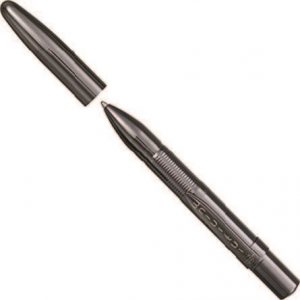
www.istockphoto.com
Infinium Space Pen • My wife has been hoarding Amazon rewards points and I think I know why. She plans to cash them in for a seat on Jeff Bezos’s rocket ship as soon as it’s ready for passengers. When that day comes, I am going to buy her an Infinium Space pen. Why someone needs to write while the earth whizzes past at 18,000 miles per hour I don’t know; perhaps she’ll just write me off at that point.
10 Year Plan: Fisher says its Infinium pen is unlikely to run out of ink in the average user’s lifetime. As someone who invariably picks up the only pen in the cup that has run out of ink, I believe $150 is a bargain. Also, the pen is guaranteed to write “anywhere, anytime, always.” (The editor in me thinks they could get rid of “anytime.”)
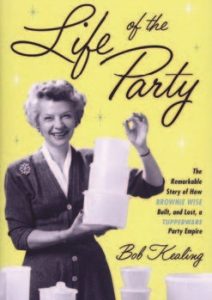 Tupperware • This is not your mother’s food storage system…okay, yeah, it is. But why mess with a good thing? The aisles of supermarkets, home goods stores and price clubs are jammed with collections of brand-name plastic food containers—often at temptingly low prices. But none of them come with a lifetime warranty or quality guarantee. It all began with a chemist named Earl Tupper back in the 1940s. He invented flexible, durable, unbreakable containers that wowed department store buyers. Unfortunately, the idea was so new (people mostly used glass containers with loose-fitting lids) that his product bombed at retail. Someone needed to explain and demonstrate what a game-changing product Tupperware was. Enter Brownie Wise, who invented the Tupperware Party— and pioneered a business model that created an income stream for stay-at-home spouses. Today that sales force numbers in the millions.
Tupperware • This is not your mother’s food storage system…okay, yeah, it is. But why mess with a good thing? The aisles of supermarkets, home goods stores and price clubs are jammed with collections of brand-name plastic food containers—often at temptingly low prices. But none of them come with a lifetime warranty or quality guarantee. It all began with a chemist named Earl Tupper back in the 1940s. He invented flexible, durable, unbreakable containers that wowed department store buyers. Unfortunately, the idea was so new (people mostly used glass containers with loose-fitting lids) that his product bombed at retail. Someone needed to explain and demonstrate what a game-changing product Tupperware was. Enter Brownie Wise, who invented the Tupperware Party— and pioneered a business model that created an income stream for stay-at-home spouses. Today that sales force numbers in the millions.
10 Year Plan: Everything Tupperware makes is built to last a lifetime, or the company will replace it. A couple of best-sellers are the one-touch canister set ($40), which has little windows that let you know when you’re running low on whatever’s inside, and the hamburger-press and keeper set ($34), which is self- explanatory. Everything is more expensive than the flimsy throwaway containers you see in the store, but it’s way, way better and, I’ll say it…weirdly retro.

www.istockphoto.com
L.L. Bean Duck Boots • Speaking of weirdly retro, L.L. Bean has been making the same boot for 100–and-something years now and I would be surprised if they aren’t sold out for 2019 by the time you read this article. I’ve never heard of anyone throwing a pair away. The treated full-grain leather uppers repel rain and snow, while the rubber-treated bottoms make the boots puddle-proof. Each pair is hand-sewn and triple-stitched by folks up in Maine who must undergo six months of training before they let ‘em near a Duck Boot.
The 10 Year Plan: No one wears these every day, but even if you did and the boots failed years from now because of poor material or workmanship, the company would send you a new pair. There are multiple styles for men and women, many with extra performance features, starting around $100.
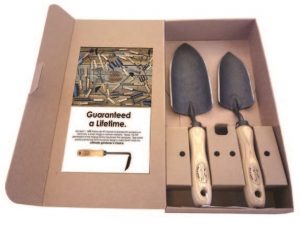 DeWit Garden Tools • These show up on a lot of “Best Of” lists for a reason: They probably are the best. Certainly, DeWit tools will easily make it to 2029 if they are not lost or stolen. That cannot be said of the less- expensive, mostly Made in China gardening tools at your local hardware store. Like the Lodge skillets, DeWit tools are made of indestructible cast iron. However, they are not manufactured in the USA. The company dates back to 1898 when a Dutch blacksmith named Willem de Wit opened a forge in the village of Kornhorn. Five generations later, Willem’s family is still running the business.
DeWit Garden Tools • These show up on a lot of “Best Of” lists for a reason: They probably are the best. Certainly, DeWit tools will easily make it to 2029 if they are not lost or stolen. That cannot be said of the less- expensive, mostly Made in China gardening tools at your local hardware store. Like the Lodge skillets, DeWit tools are made of indestructible cast iron. However, they are not manufactured in the USA. The company dates back to 1898 when a Dutch blacksmith named Willem de Wit opened a forge in the village of Kornhorn. Five generations later, Willem’s family is still running the business.
10 Year Plan: Everything DeWit makes is guaranteed forever. The family considers its tools “heirlooms.” That may be an overreach—we’re talking about gardening tools, after all—but I like the sustainability component of that word. We buy so much stuff that just gets thrown away, it’s nice to know my $60 planting trowel will still be around years from now after someone has planted me. And for the record, DeWit is sustainability-conscious, too. Their ash handles come from forests certified by the government’s Stewardship Council, which regulates the use of wood and replanting of trees in the Netherlands.

www.istockphoto.com
High-Carbon Steel Scissors • About 25 years ago, I covered the beauty industry for a West Coast business publication. For my first gig, they flew me out to Orange County on short notice and sat me across from Paul Mitchell (yes, that Paul Mitchell) at a business dinner. He was full of information, but honestly, I had no idea who he was, because he introduced himself as John Paul DeJoria (which is his legit name). We talked a lot about the new scissors coming on the market and I was stunned at the cost of a state-of-the-art salon-quality pair. A Japanese company was hawking them for $1,000 a pop and couldn’t make them fast enough.
“Wow,” I said. “That’s a lot of money for something I lose every day.” He didn’t get the joke.
10 Year Plan: So what should you pay for a pair of household shears that will look as good 10 years from now as they do today? Assuming you go with a high- leverage high-carbon steel pair, it should run you $50 or less. There are a number of brands to peruse (Vampire, Shun, Fiskars, Tangkula, Equinox—it’s a long list) and plenty of options in this price range, as different scissors do different things. Decide whether you want them for general use, for the kitchen, for art projects or for cutting fabric. And don’t make the same mistake I did. I once invested in an expensive pair of Kevlar shears thinking they were made of Kevlar. I loved the idea of scissors that could stop a bullet. Then I showed them to a work buddy and he asked when I would ever need to cut Kevlar. Cut Kevlar? Are you kidding me! The moral of the story is read the fine print. Or don’t be an idiot.

www.istockphoto.com
KitchenAid Mixer • A neighbor once said that losing her KitchenAid mixer would be like losing an arm. Being a wise-ass, I asked which of the dozen-or-so attachments laid out on the counter she would screw into her shoulder if that actually happened. “That’s a stupid question,” she responded without missing a beat. “They would all work. That’s the beauty of KitchenAid.” Touché.
10 Year Plan: Did you know that 2018 marked the 100th anniversary of the first stand mixer to carry the KitchenAid name? I’ll bet that mixer is still mixing. If KitchenAid made computers they’d probably put Apple out of business. The buy-in for a basic model is $250 to $300, with professional-grade versions going for twice that price.

www.istockphoto.com
High-Pressure Shower Head • Is there anything more private and personal than buying a showerhead? Okay, there are a lot of things. But if you do your homework, you’ll find a handful that are true difference-makers and come with guarantees that they will still be working a decade from now. High-pressure heads do great things for the mind, body, and pocketbook. A recent survey of shower-takers (now there’s an interesting job) revealed that a powerful stream of water that covers the whole body makes for a more satisfying shower. I’m not sure a survey was required to tease out that fact, but it’s worth adding that high-pressure showerheads also reduce water usage significantly because they utilize air pressure to increase the sensation of water pressure. Most are simple to install and once you tinker a bit with settings they are easy to adjust.
10 Year Plan: Two showerheads that consistently score high in consumer ratings are the handheld model by Yoo.Mee and the standard, screw-on high-pressure head by Wassa. Both work well even when the water pressure is low, and feature silicone jets, which keep mineral deposits from accumulating and blocking the water flow. The Wassa comes with a lifetime guarantee—so technically this is your 10-year buy. Yoo.Me warranties its product for a year. Given that both sell for under $25, your investment either way is minimal. If you want to explore the higher end, there are models that creep into the hundreds, including systems that offer digital control of the length and temperature of your shower.
So there you have it. Ten great gift ideas for yourself or someone else. Gifts that will be used, appreciated and still be around a decade from now. The two takeaways are fairly obvious:
1) the classics are classics for a reason (they last and are often guaranteed to last) and
2) stick with the classics.
Mariah Morgan
A few years ago, Sheryl Sandberg of Facebook fame authored a book entitled Lean In. In her book, Sandberg made the point that women in the workplace sometimes hold themselves back by not demanding the credit and respect they deserve. Women who succeed at the highest professional level do indeed face myriad obstacles— both internal and external. By the same token, history has shown us that the individuals who find ways to push past those limits not only achieve great things but serve as inspirations for all who follow. Looking back at 2009, the year the first issue of EDGE rolled off the presses, there was much to inspire, although we still had a long way to go. These nine leaders provided some of the year’s best moments….
January 12 • Brazilian soccer star Marta becomes the first player of either sex to be named FIFA World Player of the Year four years in a row.

Ludovic Péron
The heir to Mia Hamm’s unofficial title as best of the best, Marta burst onto the world soccer scene as a teenager in 2004 when she led Swedish League team Umea IK to the UEFA Women’s Cup championship. At the age of 20, she won her first Player of the Year title. Marta won for the fourth time in 2009 while splitting her time between the Brazilian national team and the Los Angeles Sol, champions of the Women’s Professional Soccer League.
10 Years Later • Marta won a fifth straight Player of the Year award in 2010 and continued her pro career in Sweden through 2016. In 2017, the cat-quick forward joined the Orlando Pride of the National Women’s Soccer League. The following season, Marta won her sixth FIFA World Player of the Year Award, at the age of 32.
January 21 • Hillary Clinton is confirmed as Secretary of State.
The Senate confirmed Clinton by a vote of 94 to 2, making her the first former First Lady to serve in a cabinet position. Yes, it was kind of a consolation prize. But “State” seemed like a great stepping stone to a renewed presidential bid in 2016. What could possibly go wrong?

Corwin Colbert US Dept of Defense
10 Years Later • Clinton used her experience and connections from the Senate Armed Services Committee to coordinate the goals of Defense and State, and to give the civilian arm of government more responsibility for responding to international crises. She and President Obama rarely disagreed and formed a surprisingly effective partnership. By the time 2016 rolled around, however, the political landscape had shifted and Clinton found herself facing Donald Trump in the election. Trump’s “upset” victory meant that America would have to wait for its first female chief executive.
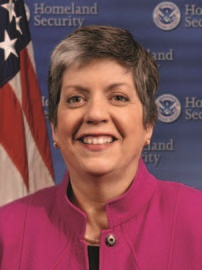
US Dept Homeland Security
January 21 • Janet Napolitano becomes the first woman to be named Homeland Security Secretary. Born in New York and raised in Pittsburgh and then Albuquerque, Napolitano was voted Most Likely to Succeed at her high school graduation in 1975. Following a meteoric law career, she was elected Governor of Arizona and was on the shortlist of VP candidates for John Kerry in 2004. In her first year as Homeland Security chief, Napolitano dealt with the Swine Flu outbreak, the “Underwear Bomber” and a rise in right-wing extremism.
10 Years Later • Napolitano left her post in 2013 to become the first female president of UCal Berkeley. She has led efforts to address sexual violence and harassment, managed tuition costs and improved the food choices available on the 10 campuses, as well as starting a carbon-neutral initiative for the school. However, Napolitano has also taken heat for misleading budget practices. In 2017, she filed a lawsuit against the federal agency she once ran after the Trump administration ended DACA.

Iceland Ministry of Social Issues
February 1 • Jóhanna Sigurðardóttir of Iceland becomes history’s first openly lesbian prime minister. Sigurðardóttir began her professional life as a flight attendant and was elected to Parliament in 1978 at the age of 36. Over the next three decades, her popularity and approval rating soared. In 2009, following the implosion of Iceland’s banking system, she was asked to lead her country out of economic free fall.
10 Years Later • Sigurðardóttir’s administration restored the economy and put safeguards in place to ensure such a financial calamity could never happen again. She also made Iceland the first Western democracy to ban strip clubs and other businesses that profited from women’s bodies. The nation is now considered the “most feminist” in the world. Sigurðardóttir retired from government life in 2013 and authored the autobiography My Life in 2017.
June 3 • Angelina Jolie, Oprah Winfrey, Madonna, and Beyoncé grab the top four spots on the Forbes 100 list of Highest-Paid Celebrities.

UN Foreign and Commonwealth Office
Big names. Big Money. A big year for female celebrities. Jennifer Aniston also made the Top 10. Jolie earned an Oscar nomination for Changeling; Winfrey was voted America’s favorite TVpersonality in a Harris poll; Madonna wrapped up a world tour and released a Greatest Hits album; Beyoncé performed “At Last” at the Inaugural Ball and was named top female artist of the decade by pretty much everyone.
10 Years Later • The top two slots are still held by women: Taylor Swift and Kylie Jenner. After that, it’s all dudes: Kanye West, soccer star Lionel Messi, musician Ed Sheeran, soccer stars Cristiano Ronaldo and Neymar, The Eagles, Dr. Phil McGraw, and boxer Canelo Alvarez. For the record, in 2019 Jolie (44) starred in and co-produced Disney’s Maleficent: Mistress of Evil; Winfrey (65) produced the disturbing documentary After Neverland for HBO; Madonna (61) released her 14th studio album, Madame X, which was the nickname Martha Graham gave her as a dance student; Beyoncé (37) voiced the character Nala in The Lion King and sang “Can You Feel the Love Tonight” with Donald Glover on the soundtrack.
July 8 • Angela Merkel succeeds George Bush as the senior G8 leader.

European Peoples Party
Four years after becoming Germany’s first female Chancellor, Merkel presided over the 35th summit of world leaders in Italy. (The G stands for “Group” if you were wondering.) She was the only woman among the G8 leaders, who made progress on issues related to climate change and infrastructure needs in Africa and also endorsed the Global Summit on Nuclear Security, scheduled for the following year in Washington.
10 Years Later • In 2012, Merkel was named by Forbes the #2 Most Powerful Person In The World—the highest-ever ranking for a woman. In 2014, the G8 became the G7 after Russia was expelled for its annexation of Crimea. In 2015, Merkel was named TIME Person of the Year. Near the end of 2018, she announced plans to step down as Chancellor in 2021. In 2019, she was awarded an honorary doctorate from Harvard.

Wojciech Migda
August 2 • 39-year-old Catriona Matthew wins golf’s British Open 11 weeks after giving birth to her second child. Despite golf’s long history in Scotland, Matthew was the first Scot to win this tournament. After a so-so opening round, she shot a scorching 67 for the second 18 holes and a 71 the next day to establish a three-stroke lead. On the final day, 2002 champion Karie Webb made a magnificent run at the lead with a 67, but Matthew birdied 13, 14 and 15 to lock up the championship by three strokes. Her daughter, Sophie, had been born on May 16.
10 Years Later • In July 2009, Matthew and her husband, Graeme, narrowly escaped a hotel fire during the Evian Championship in France. He suffered burns on his feet which prevented him from caddying for his wife. The Open victory turned out to be Matthew’s only victory in a “major.” She came close again only once, at the 2013 LPGA Championship, losing to Inbee Park in a three-hole playoff. Matthew’s lone victory on the LPGA Tour after 2009 came in 2011 at the Lorena Ochoa Invitational in Mexico.
August 8 • Sonia Sotomayor becomes the first Hispanic Supreme Court justice

Steve Petteway/
Supreme Court of the United
Following the retirement of Justice David Souter, Sonia Sotomayor was confirmed by a Senate vote of 68–31. The daughter of Puerto Rican parents, Sotomayor grew up in the Bronx and graduated summa cum laude from Princeton in 1976. She attended Yale Law School and went to work for Robert Morganthau in the New York District Attorney’s office before becoming a federal judge in 1992. Sotomayor’s ruling in 1994 ended the Major League Baseball strike.
10 Years Later • Sotomayor’s key rulings have involved the upholding of Miranda rights, immigrant rights and rights to privacy in the digital age. She has also forged some interesting alliances, including one with Neil Gorsuch over the defense of due process and law-enforcement overreach. In 2018, Sotomayor published Turning Pages: My Life Story.
October 21 • Nicole Stott participates in the first live Tweet session from outer space.

NASA
The “NASA Tweetup” initiative officially got off the ground in the fall of 2009 when Stott—one of five flight engineers on the mission—and her crewmate Jeff Williams conducted the first live Tweet session from the International Space Station (ISS). Previously, astronaut Tweets were posted on the Internet by NASA. Stott returned to the Kennedy Space Center the following month.
10 Years Later • Stott returned to the ISS on the space shuttle Discovery in 2011. Among the goals of this mission was the delivery of a humanoid robot (aka Robonaut 2). Four years later, in 2015, she announced her retirement after 27 years working for NASA. Stott’s husband, Chris, is an aerospace entrepreneur.
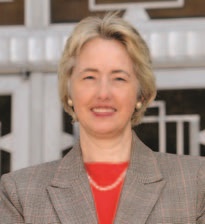
ZBlume
December 12 • Houston becomes the largest city to elect an openly gay mayor, Annise Parker.
Parker, Houston’s City Controller, finished first in a four-way mayoral race on November 11, but fell short of a majority against Gene Locke, Peter Brown and Roy Morales. Brown threw his support behind Parker in the December runoff election, while Locke received the support of two ex-mayors. Parker prevailed by 11,000 votes.
10 Years Later • Parker served three two-year terms, from 2010 to 2016, winning more than 50% of the vote both times. In 2014, she married her long- time partner, Kathy Hubbard, in Palm Springs. In recent years she has been a vocal advocate for women in government and has spoken frankly about the particular abuse female mayors endure from their critics. In 2019, Houston was eclipsed by Chicago as the largest city with an openly gay mayor when it elected Lori Lightfoot.
Mark Stewart
In the old days, they would have a “triple threat.” Indeed, the two- time Tony winner can sing, he can dance and he can act. But these are not the old days, and the bar is much higher than it used to be in the performing arts—as Butz would be the first to tell you. On the stage and screen, he is both a portrayer and creator of characters large and small, with a well-earned reputation for knocking it out of the park. Now the longtime Maplewood resident has hit his stride as a composer and performer, releasing The Long Haul, a collection of honest, earthy songs written at different stops on a journey that has taken him to the Broadway stage (Rent, Dirty Rotten Scoundrels, Catch Me If You Can, My Fair Lady) and earned him roles on a pair of groundbreaking TV series (Bloodline on Netflix and Mercy Street on PBS). EDGE editor Mark Stewart was curious how the words and lyrics of The Long Haul fit into the tapestry of Butz’s career as an artist and entertainer. It turns out that those threads run deeper than even his most ardent fans might imagine.
 EDGE: The Long Haul is your fourth album, but also in some respects your “first.”
EDGE: The Long Haul is your fourth album, but also in some respects your “first.”
NB: Yeah, it’s the first time I’ve put something out that’s all my original songs. The title says it all…it’s a long, long labor of love. You know, I’ve always written in my downtime— between acting gigs or if I’m on a set and waiting a long time, or when I’m out of town in hotel rooms. It was recorded mostly during the time I was finishing up Bloodline in the Florida Keys. I had a bunch of tunes and I sent them to my friend, Jason Loughlin—a great guitar player, producer, arranger in Williamsburg, Brooklyn— and said, “Hey, man. I think I might have an album here.” He really responded to the songs so we hired a band and got some studio time. It was kind of stop-and-start. I’d get a couple of things recorded, but then a job would take me away and I’d shelve it for a while. This past year I was really busy with My Fair Lady at Lincoln Center. It took over a year-and-a-half to record.
EDGE: Are you one of those guys who can just sit down and bang out a song?
NB: No, I’m not. I must have a thousand ideas for songs on my phone. Going back to college, I‘ve always written songs for my own pleasure. So starting them is easy, but the hard work of actually finishing them is much more difficult. I have friends who are real songwriters. They show up every day and work four to six hours on their songs. I never had that discipline or that kind of time.
EDGE: So why now?
NB: Getting the songs out was about moving past some of the really difficult moments for me during my 40s. It was a tough decade. I lost several family members. It felt good to release it.
EDGE: When I listen to the album I hear more than a little Dr. John. Some Al Green. And some Springsteen.
NB: That’s cool. I’m flattered. I think those are apt comparisons. I really do love Soul music and Blues and Gospel music. I was raised on a lot of that in St. Louis. There is a really rich tradition of Blues in that part of the country. My parents were deeply religious—my father, in particular, listened to a lot of Gospel—and we were in church constantly. So those are the sounds I grew up with and I suppose they’ve always stuck with me. It’s funny you should say Springsteen because now I live in New Jersey and I definitely credit him as a huge influence on me, going back to when I was a kid.
EDGE: I have to ask a Dirty Rotten Scoundrels question…Steve Martin had to fill a screen when he played Ruprecht but you had to fill an entire stage—with John Lithgow a few feet away—how do you rise to that challenge?
NB: No one can really rise to the challenge of John Lithgow. He’s like 6’5” [laughs] so rising to that challenge is like spitting in the wind. You know, in a lot of ways John played the straight main in Dirty Rotten Scoundrels. He gave me permission to take as much stage as I wanted to. It was a blast. John is one of the most generous, loving, creative, supportive partners anyone could hope for. You know, I was really intimidated at first to be working with him. I was a was this enormous international celebrity. We’ve remained really dear friends and he has been a touchstone for me.
EDGE: How so?
NB: I go to him so much, just in terms of teaching me how to lead a cast with real grace, how to be super generous. His basic goodness. His workmanlike attitude. How to behave in front of a company. How to do this business over the long haul. How to build a diverse, multimedia career that I didn’t even know I aspired to before I met him. Now I know how valuable that is. He’s just the best. Even putting out this record, in some ways, was inspired by him. This idea that you don’t have to be just a performer, that you can make your own work during the in-between time when you’re waiting for directors and producers to tell you you’ve booked a job.
EDGE: A few years later you were Carl Hanratty, who lives somewhere at the other end of the spectrum from Ruprecht. What did you enjoy about that character?
NB: That was a really incredible experience. And I have to be honest, one that I did not see coming. It fell into my lap. Jack O’Brien, who also directed me in Dirty Rotten Scoundrels, sent me the script and said, “I think I’d like to see you do this. What do you think?” I had seen the Spielberg film in which Tom Hanks had played the role. I said, “I just don’t get it. I don’t get why you think of me for this part.”
EDGE: What made you see it his way?
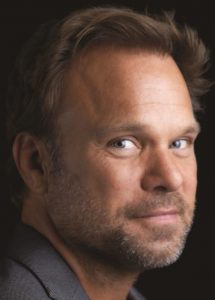 NB: When I got the script I realized that Catch Me If You Can is really the story of a lost kid in search of a surrogate father, and this lonely, middle-aged gumshoe cop really looking for a surrogate son. My dad, who has since passed away, was really ill at the time. I was quite emotional thinking about him. I found the story really, really moving in a way that I didn’t expect to. It was very personal. Sometimes it’s not clear to audiences what draws an actor to something. For me, as an actor, that’s always the way in, the personal, emotional hook. It was a ball. It was a chance for me to do a real character part in a big Broadway musical.
NB: When I got the script I realized that Catch Me If You Can is really the story of a lost kid in search of a surrogate father, and this lonely, middle-aged gumshoe cop really looking for a surrogate son. My dad, who has since passed away, was really ill at the time. I was quite emotional thinking about him. I found the story really, really moving in a way that I didn’t expect to. It was very personal. Sometimes it’s not clear to audiences what draws an actor to something. For me, as an actor, that’s always the way in, the personal, emotional hook. It was a ball. It was a chance for me to do a real character part in a big Broadway musical.
EDGE: Hanratty was kind of a blank slate.
NB: He was. I got to really invent him. By the way, there was never a Carl Hanratty. He was based on several guys. They got the name from Tom Hanks.
EDGE: How did you hear this story?
NB: Tom sent me a note to the theater, typed on his famous vintage typewriter. It said Norbert, congratulations on Catch Me If You Can. He eventually came to see it and he said, “Let me tell you how the character came to be named Carl Hanratty.” He said on the first day of shooting they hadn’t named him because they couldn’t legally use the name of any of the FBI agents who were involved in the case. Spielberg turned to Tom and asked, “What are we going to name this guy?” Tom told me he named him Hanratty for a football player his dad loved at Notre Dame, and he named him Carl because it had the K sound in the name and that’s funny. And he’s right. Carl is a funny name.
EDGE: You’d mentioned My Fair Lady. You played Eliza’s father, Alfie Doolittle, a character that everyone has probably seen at least once or twice on some stage or in the movie. How do you bring something new to that role?
NB: No one believes me, but I was almost 50 years old when I got that part and I had never seen a production of My Fair Lady. And I never watched the film all the way through—only pieces of it when it came on cable late at night. I knew Pygmalion because I’d done a big course on George Bernard Shaw when I was in graduate school. Similarly to Catch Me If You Can, when the director asked me to do this part, I said, “What? I’m only 50. Why would I want to play this old drunken character?” But I went and read the script for really the first time as if it were a new piece, and thought This is a great part! Just that sardonic humor and the dichotomies within the character, and the great numbers. Also, it was truly a dream of mine to work on the big stage at Lincoln Center. When I came to New York the very first place I went as a young actor was to see Tom Stoppard’s Arcadia at the Vivian Beaumont, and I thought Man, to get on to that stage, you’ve really made it. I leaped at the opportunity and had the most wonderful time doing My Fair Lady.
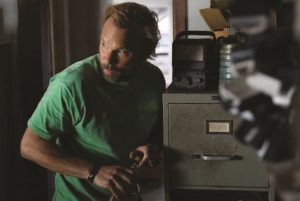
Netflix
EDGE: Let’s switch to television for a moment. The characters you played on Bloodline and Mercy Street were absolutely spot-on. Everyone knows someone like Kevin Rayburn, who just can’t seem to get out of his own way, and you were beyond believable in that part. Did you base your portrayal on people you’ve come across in life?
NB: The show was about a family that literally is trying to keep its head above water, and as an actor sometimes that’s what it felt like. It was really potent when it worked. I would like to say that I based Kevin on someone—or even had time to prepare. But the fact is that in Bloodline—which was produced by a trio of writer/creators, Glenn and Todd Kessler and Dan Zellman, who also did Damages, starring Glen Close— they famously withheld information from the actors.
EDGE: So you’re not getting a script until a day or two before?
NB: Right, and often they shot alternative versions of scenes! They were largely putting the editing together while they’re making it. As an actor, it was a real lesson in not knowing what was coming next. Also, they would shoot scenes out of order and the show’s narrative kept going back and forth in time, so I couldn’t get a handle on, like, I know where this is going, so I could make choices. Each night we’d get scripts to shoot the next day and I’m like, I don’t know how I end up here. Yesterday, I was shooting this scene where Kevin seems like a pretty good guy and today I’m shooting a scene where I’m in my underwear doing cocaine with a gun in my hand [laughs]—and they don’t necessarily tell you how you got there. It was really challenging, but it became a fun experiment in letting go into what you don’t know and treating each scene like it’s own little mini-movie with its own beginning, middle, and end. So if it looked like Kevin didn’t know what he was doing, that’s me. It was not an easy shoot. The stakes were so high and the material was so dark. But I loved it. We were down in that incredible locale in the Keys and it infected everything we did. There was no make-up— that’s really real sweat, that’s really real sunburn, my hair was really bleached out and those are real mosquitoes eating us up in the shots. It was like nothing I’d ever done before.
EDGE: I have a similar question about the character you played on the PBS series Mercy Street, Dr. Hale. Everyone has bumped up against someone like that guy, who has reached the limit of his talents and is threatened by people with new skills and new ideas, and who kind of embraces bureaucracy in the face of change—
NB: Which made the part so much fun to play! Yeah, that guy did not know his head from his rear end.
EDGE: Who were you thinking about when you played him?
NB: He was so pompous, so full of himself and thin-skinned and easily threatened. He reminded me so much of Frank Burns on M*A*S*H*. I loved that show and actually thought a lot about Frank. You’re right. He wants things to stay the same. He’s dying to be an administrator behind a desk. I thought what was interesting about the character was that here he is, in the middle of the Civil War, but still looking for creature comforts and vices— sex and booze—to help mitigate the reality of the war. That felt really human to me. Imagine the carnage during the Civil War, before morphine is being used regularly in surgeries—just the violence—it must have been so incredibly difficult to process. It doesn’t surprise me that these doctors tried to find pleasure wherever they could.
EDGE: You’ve lived in New Jersey going on 20 years. What drew you to the state initially and in what ways has it grown on you?
NB: I came kicking and screaming, I’ll be totally honest. My first two girls were born in Brooklyn and we really wanted to stay there. We lived in Park Slope. We needed more room and I thought I’d be able to find a brownstone somewhere, but this was right when the housing bubble was starting to get really whacky and I just couldn’t afford a bigger space. My wife and I had friends who’d moved to Millburn and we were out visiting them and we looked around there. We liked what we saw, the schools were good, it was doable. So we moved to Millburn. Still, I didn’t really want to come. I like Springsteen as much as the next guy…but it was Jersey, you know?
EDGE: I am a transplant, too. When I left New York City in the 80s my friends acted like I’d been shot out of a cannon.
NB: Yeah [laughs] when you leave New York your family stops talking to you. No one comes to visit. But then something really remarkable happened. It took me a few years, but I’m the biggest fan now of where I live. I’m such a huge Jersey fan.
EDGE: What I like about New Jersey is that there are 500-plus towns and each is completely self-contained, so even though everyone you know is from “here,” somehow almost everyone is also from “somewhere else.”
NB: I do, too, man. You’re so right about that. We lived in Millburn for a couple of years and moved to Maplewood after that. I can walk to Millburn from where I live. But the character between the two towns is wildly different. I just find that super-interesting. I love Maplewood, Millburn, South Orange—now my third daughter is going through the school district. I love it. It’s such a tight community. It’s progressive, inclusive, beautiful. And as a point of departure, it’s fantastic. It’s close to the city, I’m eight miles from Newark Airport, I can be in the Poconos in an hour, we can be on the beach, or points north in the Hudson Valley, in 45 minutes. It’s a gorgeous state, filled with tons of farms, great rivers, places to camp and hike. I’ve just fallen in love with it.
You started in movies really late. Do you think it was good in a way for you?
Absolutely. I was 20 years on the stage in New York prior to getting the movie career, as such, though I did do television work, I did some movies. I think the training—both in the profession and in life—was to my benefit. When I was working in the ‘70s and ‘80s, the drug culture was booming and a lot of people didn’t make it through it. I was very peripatetic when I was young, back-and-forth cross-country, to New York to Los Angeles to San Francisco, trying to find the doorway, where to be able to get in. It’s just being in the right place at the right time.
Which is better, to be the President, to be God, or to be a movie star?
Movie star.
Why?
It pays. None of the rest of them pays. Not nearly as well.
What are the cons of being a movie star?
Well, first, it’s what I wanted from a very young age, I wanted to be in the movies. But as you start to watch your career go on, you realize that you didn’t want to be “star.” If you are a character actor, you don’t want to be a star, because you can’t be a character. A star very rarely gets roles like Quasimodo. Bob De Niro could walk down the streets unrecognized after he had done Bang the Drum Slowly, Godfather II and Raging Bull. He had done all these well-received movies, but he could walk down the street unrecognized. That’s character acting, when you hide, when you become the character, that’s the essential difference to me.
When you were a kid, did you ever dream about being the President?
No, I only dreamed about being an actor. When I was a kid, I went to the movies every day I could find enough money. President? CEO of something? No. Later on, I thought it might have been interesting to have been a racecar driver.
Is that on your bucket list?
I’ve done it!
Is there anything left on your bucket list?
I wanted to be a jet pilot. I wanted to be a sailor, a water sailor. I wanted to be a cowboy—I’m a good horseman, I love horses and live with them. And the rest of it is just to be here, to enjoy life.
When you play the President, do you take pleasure in it?
The pleasure is in working. Believing that you are the President or God or the devil or whatever, the only joy in that is bringing the character to life. I don’t get any personal sense of the power of God or the power of the President. Make believe is make believe. I hate for people to somehow gloss over that and say, “Oh my God! God just walked in the room!” Don’t do that.
Editor’s Note: Morgan Freeman played the President in his most recent film, Angel Has Fallen, co-starring with Gerard Butler. He is due to star in four films in 2020, including the action comedy The Hitman’s Wife’s Bodyguard, with Ryan Reynolds, Salma Hayek and Samuel L. Jackson.
This Q&A was conducted by Sarah Williams of The Interview People.
At only 10 years old, Alexa Swinton has become the talk of the 2019–20 TV season. You’ve seen her in Showtime’s Billions and on The Tonight Show and Saturday Night Live, but she has earned her first starring role in the ABC sci-fi drama Emergence. Alexa more than holds her own with screen veterans Allison (Fargo) Tolman, Clarence (Shawshank Redemption) Brown and Donald (Scrubs) Faison. A longtime (relatively speaking) New Jersey resident, she shot the first season of Emergence right here in the Garden State. Veteran EDGE interviewer Gerry Strauss found her to be full of surprises.

Photographer: Emily Assiran • Hair & Make-up: Evy Drew • Stylist: Jenn Rosado
EDGE: Is this the first you’ve heard of Edge Magazine?
AS: It’s really funny because I’m actually in love with this magazine. I’ve been going to this place called Karma Organics Spa in Ridgewood since I can remember. They have Edge Magazine there, so that’s what I’ve grown up reading.
EDGE: When you first started preparing for your role in Emergence, how did they describe the character of Piper to you?
AS: Oh, wow. They described Piper as this mysterious girl who’s sweet and doesn’t remember anything about herself. I was very intrigued by just that.
EDGE: You handle this role impressively. Do you think you would have been comfortable working on a show this terrifying a year or two ago?
AS: I feel like I could’ve definitely handled it because I would’ve worked just as hard. It would’ve been a tiny bit harder for me, but obviously I would’ve still enjoyed it and still worked on it.
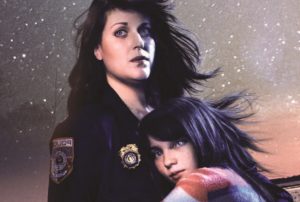
ABC Studios; Swinton with co-star Allison Tomlin
EDGE: Before you started working on the show, did you know anything about co-star Allison Tolman?
AS: I’d heard of Good Girls actually, because my class watched it, and they were like, “Oh my God! Isn’t that the person who played that evil character on it?” And I was like, “I don’t know.” Then I realized that it was, and I was like “Oh God, you guys talk about her all the time.”
EDGE: Has she given you any advice, or helped you? Are you friendly behind the scenes?
AS: Yes, it’s a close family, it’s a really great set family. I feel like we really lucked out, because some sets don’t love each other the way I feel like our relationship is. Allison always says be nice to the crew, because you are one of them and they are one of you. She’s just the best and nicest person you’ll ever meet.
EDGE: Who would you say is the funniest person that you have acted with so far?
AS: My mom! She’s an actress, writer and stand-up comedian and we are collaborating now on a film based on her immigration at age 9 from the Soviet Union to New Jersey in the 80’s. I play my mom. We are also working on a book series about a fourth-grader named Skylie—based on me and my siblings and friends—who lives in New Jersey. So all New Jersey-focused projects.
EDGE: What about on Emergence? In this family that you work with, who’s the comedian there?
AS: I think that they’re all really funny, I feel like role- wise though, I think that Clancy Brown takes it, only because his role has been the funniest. But I feel Donald Faison comes in second for Murray on Clueless, and Turk on Scrubs. And then, Allison comes third because I’ve not watched Downward Dog, the only comedy she’s done that I’ve heard of.

Photographer: Emily Assiran • Hair & Make-up: Evy Drew • Stylist: Jenn Rosado
EDGE: If you could do a voice for a character on TV, which show would you like to be on?
AS: SpongeBob. If there’s ever a recreation of it, I’d definitely love to be a SpongeBob character. I feel like Sandy would definitely be number one on my list. I would also love to be in The Good Place. It’s the best show ever. It’s really funny, and I just think that I’d love to be on there.
EDGE: Do you have any actors who you hope you will get to meet and work with someday?
AS: I definitely really want to work with the whole cast of Friends. They’re really just amazing people, and I feel like they really have done so much work that I really feel is great. But I’d also love to work with Jerry Seinfeld. He’s really funny.
EDGE: What’s the best movie that you’ve seen in the last year or so?
AS: Ready Player One. It was the best movie ever I think because it really shows the way that the world could be, everyone addicted to this one thing.
EDGE: What are some of your favorite things to do when you aren’t working?
AS: I love the malls, especially Garden State Plaza, which is like a whole city. We love the movie theater and the shoes at Nordstrom during their sale. I also love bicycling in the bike path along Saddle River Park, from Paramus to Glen Rock to Ridgewood.
EDGE: Are you more of a New Yorker or a Jersey Girl?
AS: I was born in New York and do have a special love for it, as well. I mean I have been auditioning in the city since I was three, and I have many favorite places and neighborhoods there. But I am proudly a Jersey Girl!
EDGE Editor’s Note: Emergence scored a 93 among TV critics on the Rotten Tomatoes web site, with reviewers noting parallels with Stranger Things and Lost, and Alexa’s performance in a difficult role drawing comparisons to Millie Bobby Brown.

